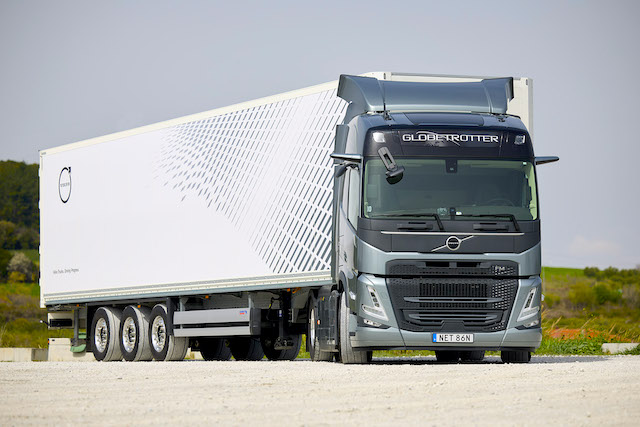Did it refer to Éole where Volvo Trucks chose Greece for the first press drives of its FH Aero range? Still, the aerodynamic improvements can be heard … with the silence provided on board!
What differentiates the 2024 Volvo FH Aero most from the previous Volvo FH? We can answer with certainty: walking silence! The Volvo FH was certainly not a noisy truck, but the progress achieved with the FH Aero series (see also eMag n°17 March 2024 and also ) can be heard by the ears.
The front, with a 24cm hood and front bumper, reduced gaps between bodywork elements, the introduction of additional skirts and deflectors, and the mounting of rear cameras, certainly contribute to this impression. Obviously, this very high level of soundproofing is promoted by FH Aero Electric. A feat because, in an electric truck, the suppression of engine noise reveals everything that is usually hidden: noise from air compressors, transmission, tires, suspension of the cabin or chassis, body work, etc. Even on electric power, the results are absolutely amazing and show the quality of the cabin assembly. Note how the Continental Efficient Pro S+ and Pro D+ tires were fitted on board all models tested during this day of fast driving in Northern Greece.
The only disappointing reasons for the electric are the unimpressive engine performance (even for 36t GVW) and the transmission in which the gear changes are still noticeable, in the torque break during acceleration and in terms of acoustics. Likewise, when descending, when gaining energy, there is a lack of linearity. There’s really nothing like a good recoil pad to combine softness and grip.
FH16 Aero or the embodiment of quiet power
Interestingly, there was a new FH16 Aero kit in a 6×4 tractor silhouette. Loaded with 40t, it literally “walks” on this uneven course which, luckily, saves a good number of gear changes. Enter in 11th at less than 60km/h it’s just routine as the machine is overflowing with torque (3800Nm and 780hp version). For very uneven courses and steep gradients, even for “road” applications with 40 or 44t GVW, there is no doubt that the 6-cylinder engine of 17.3 liters will be appreciated for its ability to pull any gear without playing.
In terms of use, we lose on the one hand (increased cylinder capacity) what we gain on the other hand (reduction in the number of gear changes, lower engine speed), as long as we do not allow ourselves to be carried away by this cinematic chain. In short, on a hard road, there is no guarantee that it loses against the most popular low-displacement model. To be proven in the field, while considering the tax and weight penalty compared to the D13 engine. Another advantage of the FH16 2025 is the breaking of the VEB engine, finally giving the impression of benefiting from a real basic retarder. Of course, there is always a loss of braking when changing gears, but of course it is with this engine that Volvo Engine Brake shows itself at its best (it can develop up to 525kW of braking).

Unknown point values
For good measure, Volvo Trucks brought a classic Volvo FM 500 with retro cameras (always supplied by Stoneridge) on its tour of Greece. A solid model for regional or national expansion with occasional offshoots. The latter is at the same level as in the FH with the benefit of a significantly improved field of vision and accessibility due to the reduction of the cabin threshold. Removing the mirrors makes it much easier to approach junctions and roundabouts by removing the intrusive blind spot.
Despite the reduction of the frontal area compared to the FH – a guarantee of lower consumption – the FM was the noisiest of the whole group in terms of engine and aerodynamic turbulence. Proof that the FH Aero specification is not cheap. Another “old friend” but also available in Aero version, Volvo FH Aero 460 Turbocompound. The configuration of the Volvo i-Shift gearbox together with the latest refinement of the Volvo i-See theme highlights the amazing availability, from the lowest modification, of this D13 engine variant.
All things considered, the Turbocompound version gave us an impression of the simplicity of the FH16 780. To be proven, in both cases, on a demanding route such as Lyon-Toulouse via RN88. If this help in managing consumption has convinced us, we will not say the same about the automatic reading of signs and the automatic setting of the speed limit. Some errors in interpreting the system caused us to slow down a few times at 40km/h in the middle of a lane on a road with no markings nearby. It is clear that none of these driving aids (unfortunately made mandatory with the GSR2 from July 7) will justify complete confidence during our various drives, regardless of brand. Information for drivers: stay alert, especially on the road and, wherever possible, be ready to take action in all situations.
Image 1 of 8
Volvo FH Aero 460 Turbocompound view of the aerodynamic skirts

























